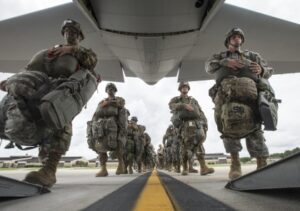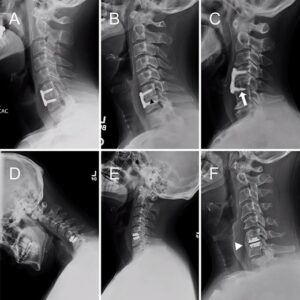
Soldiers from the 82nd Airborne Division board a C-130 Hercules aircraft at Pope Field, NC, in 2016, lugging about 100 lbs of gear each. Spinal problems are common for active-duty servicemembers, according to a new study. U.S. Army photo
BETHESDA, MD — Surgical procedures for cervical degenerative disc disease, including anterior cervical discectomy and fusion (ACDF) or cervical disc arthroplasty (CDA), are safe and effective therapies for active duty servicemembers in overseas military medical facilities, according to a recent study.
The retrospective analysis published in the journal Military Medicine evaluated whether surgical therapies for those conditions could be performed safely and effectively in overseas MTFs, which has not been previously studied.1
The study also determined the rate of return to duty from ACDF and CDA surgeries for cervicalgia, cervical radiculopathy and cervical myelopathy at overseas military medical facilities. In addition, the analysis identified “situations in which surgical procedures should be considered to maximize unit readiness, while avoiding the need to perform aeromedical evacuation or tour curtailment for common medical conditions,” the study reported.
The research team included researchers from Walter Reed National Military Medical Center and the Uniformed Services University of the Health Sciences, both in Bethesda, MD, and the Naval Medical Center San Diego..
In U.S. active duty servicemembers, common causes of disability are cervicalgia, cervical radiculopathy and myelopathy. The researchers analyzed data from the neurosurgical database of an overseas military medical facility, U.S. Naval Hospital Okinawa, that was gathered over a two-year period (July 2019 to June 2021). Patient and procedural data were collected to include ACDF or CDA surgery, military rank, age, tobacco use, pre- and post-operative visual analogue scales for pain and presence of radiographic fusion after surgery for ACDF patients or heterotopic ossification for CDA patients. Statistical tests were performed to identify variables associated with return to full duty, the study explained.
The participants were 47 patients (25 ACDF and 22 CDA) who underwent surgery, with an average follow-up of 192.1 days. Forty-one patients (87.2%) were able to return to duty without restrictions, 10.6% of patients remained on partial or limited duty at their latest follow-up, and one patient was medically separated from the surgical cohort. The data reported one complication, and one patient required shortened overseas tour duty for ongoing symptoms, the study reported.

Postoperative X-ray evaluation in anterior cervical discectomy and fusion and cervical disc arthroplasty. A postoperative bony fusion across the disc space (A) is demonstrated 6 months after a C6–7 anterior cervical discectomy and fusion. A patient (B) who is asymptomatic, but has indeterminate fusion (black arrowhead). A patient (C) who presents years after her surgery presents with neck pain and evidence of hardware facture from a nonunion (white arrow). A patient (D and E) with a successful arthroplasty demonstrating preserved motion on lateral X-ray flexion and extension. A patient (F) with evidence of heterotopic ossification (white arrowhead) across the index level preventing motion of the arthroplasty.
The study found that “military patients with cervicalgia, cervical radiculopathy and myelopathy may be treated safely and effectively with ACDF or CDA at overseas military medical facilities. These procedures can be performed with minimal interruption to the patient, their family and the military unit, with high rates of pain relief and return to full duty without limitation.”
The researchers demonstrated “high rates of return to full duty without limitation following either anterior cervical surgery, with 87.2% of servicemembers returning to their unit in the follow-up period. Also, 83.0% of all patients reported greater than 50% reduction in their pain after surgery. Patients who returned to full duty without limitation versus any other duty status, partial or limited duty and medical separation, were older (ages 39.2 versus 36.8) and of higher rank, E7 or higher (80.5% versus 50.0%), though these differences weren’t statistically significant.”
Only three female patients were included in the study, which indicated that female sex was predictive of not returning to full duty without limitation. The difference of age between patients undergoing ACDF versus CDA can likely be attributed to changes from degeneration of the bones and disks in the neck usually found in older patients, such as height loss and loss of lordosis, which disqualify patients from CDA, the study authors suggested.
Cervical degenerative disc disease, a common disorder that presents with cervical radiculopathy, cervicalgia or cervical myelopathy, could be linked to chronic pain or disability. Another study found that nearly 25,000 active duty service members were diagnosed with cervical radiculopathy in a 10-year period, likely because the physical demands of an active duty military career appear to increase the incidence of cervical injuries and degeneration.
The symptoms and reduced capability of cervical degenerative disc disease might also have a negative impact on unit readiness and lead to unit degradation and tour curtailment, the authors posited, explaining. “Musculoskeletal injury, including nontraumatic cervical spine conditions, was a leading cause of medical evacuation from Operation Enduring Freedom in Afghanistan and Operation Iraqi Freedom.”
“ACDF, CDA and posterior decompression are often considered as treatment for patients who fail nonsurgical, conservative measures, such as physical therapy and medical or interventional pain management,” the study added.
This study’s data “may be useful to physicians, hospital administrators and unit commanders when evaluating the risks and benefits of treating active duty service members overseas for these medical conditions.” The researchers hope this study will help “demonstrate the benefits of maintaining a broad, inclusive surgical practice while overseas,” the researchers pointed out.
Limitations of the study include its “small population size, the retrospective nature of the study, the single surgical provider, and absence of a validated outcome measure. There was also a lack of standardized follow-up and significant variability in the follow-up among patients,” according to the authors.
- Dewar C, Ravindra VM, Woodle S, Scanlon M, Shields M, Yokoi H, Meister M, Porensky P, Bossert S, Ikeda DS. Effect of Fusion and Arthroplasty for Cervical Degenerative Disc Disease in Active Duty Service Members Performed at an Overseas Military Treatment Facility: A 2-Year Retrospective Analysis. Mil Med. 2023 Jul 25:usad280. doi: 10.1093/milmed/usad280. Epub ahead of print. PMID: 37489817.
